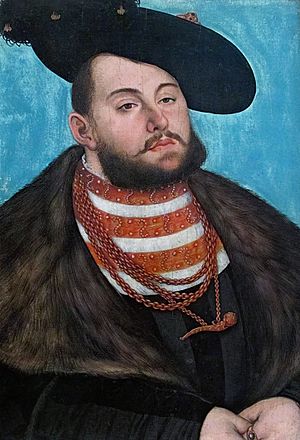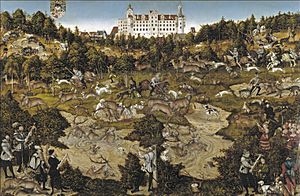John Frederick I, Elector of Saxony facts for kids
Quick facts for kids John Frederick I |
|
|---|---|

Portrait by Lucas Cranach the Elder, 1531
|
|
| Elector of Saxony | |
| Reign | 16 August 1532 – 24 April 1547 |
| Predecessor | John |
| Successor | Maurice |
| Duke of Saxony | |
| Reign | 24 April 1547 – 3 March 1554 |
| Predecessor | Maurice |
| Successor | John Frederick II |
| Landgrave of Thuringia | |
| Reign | 16 August 1532 – 24 April 1547 |
| Predecessor | John |
| Successor | John Ernest |
| Born | 30 June 1503 Torgau, Electorate of Saxony, Holy Roman Empire |
| Died | 3 March 1554 (aged 50) Weimar, Electorate of Saxony, Holy Roman Empire |
| Burial | St. Peter und Paul, Weimar |
| Spouse | Sybille of Cleves |
| Issue | John Frederick II, Duke of Saxony John William, Duke of Saxe-Weimar John Frederick III, Duke of Saxe-Gotha |
| House | Wettin (Ernestine line) |
| Father | John, Elector of Saxony |
| Mother | Sophie of Mecklenburg-Schwerin |
| Religion | Roman Catholic (1503-1521) Lutheran (1521-1554) |
| Signature |  |
John Frederick I (born June 30, 1503, in Torgau – died March 3, 1554, in Weimar) was an important ruler in Germany. He was known as "the Magnanimous" (meaning "generous" or "great-hearted"). From 1532 to 1547, he was the Elector of Saxony. An Elector was a powerful prince who helped choose the Holy Roman Emperor. John Frederick was also a leader of the Schmalkaldic League, a group of Protestant princes and cities.
Contents
Early Life and Education
John Frederick was the oldest son of John, Elector of Saxony, and his first wife, Sophie of Mecklenburg-Schwerin. Sadly, his mother passed away just two weeks after he was born.
He was taught by George Spalatin, a close friend and advisor to Martin Luther. Because of Spalatin's teaching, John Frederick became a strong supporter of Luther's ideas. He loved history and had one of the biggest libraries in Germany for his time.
John Frederick became very close to Martin Luther. They started writing letters to each other when Luther was facing serious trouble from the church. John Frederick made sure Luther's writings were printed. He even built a special chapel in his castle at Torgau for Lutheran worship and invited Luther to speak there.
His father also taught him about politics and diplomacy. John Frederick helped with important discussions, even when he was young. He also went with his father to the Diet of Augsburg in 1530. A Diet was a big meeting of rulers and important people. At this meeting, he signed the Augsburg Confession, which explained the beliefs of the Protestants. His strong support for Luther's ideas made the Emperor dislike him.
Becoming Elector of Saxony
In 1532, John Frederick became the Elector of Saxony after his father died. At first, he ruled with his half-brother, John Ernest, Duke of Saxe-Coburg. But by 1542, he ruled alone.
John Frederick was a very open and impulsive person. Sometimes, he didn't listen to his experienced advisors, which could lead to problems for his country.
He worked to make the Lutheran Church stronger in his lands. He also strongly supported the Schmalkaldic League. This league was a group of Protestant states formed to protect themselves against the Holy Roman Emperor, Charles V, who was Catholic.
John Frederick did not want to support any church councils called by the Pope. He believed these councils would only try to keep the Pope's power. Instead, he asked Martin Luther to write down all the important beliefs that Protestants would stand by. Luther wrote the Schmalkald Articles for this purpose.

John Frederick was very determined about his religious beliefs. He sometimes made decisions that caused trouble. For example, in 1541, he chose Nicolaus von Amsdorf to be the bishop of Naumburg, even though the Emperor had chosen someone else. He also helped bring the Reformation to other cities like Halle, Goslar, and Brunswick.
Emperor Charles V needed the help of the Protestants for other wars, so he seemed to agree with some of their changes. John Frederick thought that peace had come and continued to make religious changes in his country.
The Schmalkaldic War and Capture
In 1546, the Schmalkaldic War began. This was a war between the Catholic Emperor Charles V and the Protestant Schmalkaldic League. John Frederick led his troops south. However, his cousin, Maurice of Saxony, unexpectedly invaded John Frederick's lands. John Frederick had to return home to fight Maurice.
He managed to win back most of his lands and push Maurice back. But then, Emperor Charles V quickly moved north and surprised John Frederick. On April 24, 1547, the Battle of Mühlberg took place. John Frederick's army was defeated. He was injured in the face and taken prisoner by Charles V.
Life as a Prisoner
Emperor Charles V wanted to punish John Frederick severely. However, John Frederick's wife, Sybille, was bravely defending the city of Wittenberg. To avoid a long fight, the Emperor decided not to carry out the death sentence.
To save his own life, protect his wife and sons, and stop more fighting, John Frederick agreed to the Capitulation of Wittenberg. This agreement meant he had to give up his rule to his cousin Maurice. In return, his death sentence was changed to imprisonment for life.
Final Years and Legacy
John Frederick remained a prisoner for several years. However, in 1552, his cousin Maurice suddenly attacked the Emperor. This led to John Frederick's release on September 1, 1552. He refused to change his religious beliefs and declared he would stick to the Augsburg Confession until he died.
His journey home was like a victory parade. After five years, he met his family at Wolfersdorf Castle. He had built this castle as a hunting lodge earlier, and he renamed it Schloss Froehliche Wiederkunft, which means "Palace of Happy Returning."
He moved the government to Weimar and worked to improve his country. He especially cared about the University of Jena, which he planned to build to replace the University of Wittenberg, which he had lost. He passed away in Weimar just two years after his release.
Family Life
On February 9, 1527, John Frederick married Sibylle of Cleves in Torgau. Sibylle was the daughter of John III, Duke of Cleves. She was also the sister of Anne of Cleves, who was briefly Queen of England as the fourth wife of King Henry VIII.
John Frederick and Sibylle had four sons:
- John Frederick II, Duke of Saxony (born 1529 – died 1595)
- John William, Duke of Saxe-Weimar (born 1530 – died 1573)
- John Ernest (born and died 1535)
- John Frederick III, Duke of Saxe-Gotha (born 1538 – died 1565)
See also
 In Spanish: Juan Federico I de Sajonia para niños
In Spanish: Juan Federico I de Sajonia para niños
- Portrait of John Frederick I, Elector of Saxony
Images for kids





